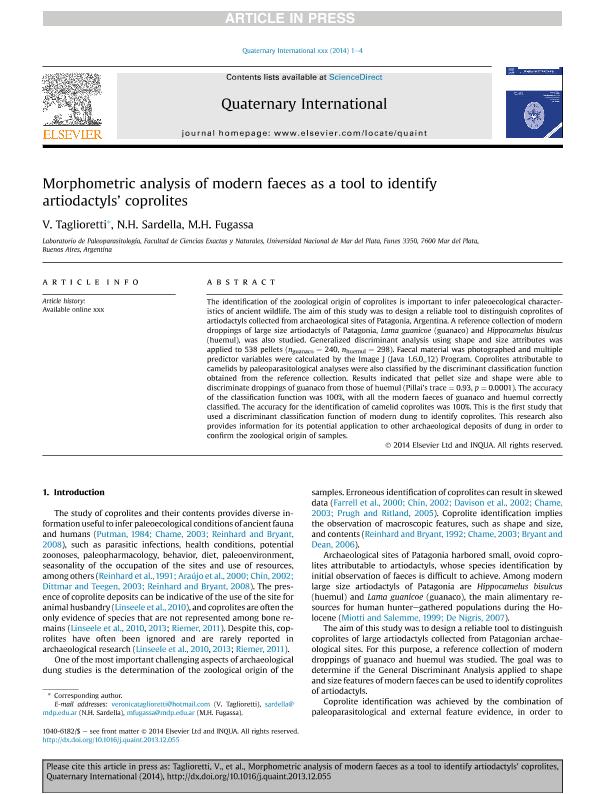Mostrar el registro sencillo del ítem
dc.contributor.author
Taglioretti, Verónica

dc.contributor.author
Sardella, Norma Haydee

dc.contributor.author
Fugassa, Martín Horacio

dc.date.available
2018-01-30T19:48:14Z
dc.date.issued
2014-11
dc.identifier.citation
Taglioretti, Verónica; Sardella, Norma Haydee; Fugassa, Martín Horacio; Morphometric analysis of modern faeces as a tool to identify artiodactyls' coprolites; Pergamon-Elsevier Science Ltd; Quaternary International; 352; 11-2014; 64-67
dc.identifier.issn
1040-6182
dc.identifier.uri
http://hdl.handle.net/11336/35114
dc.description.abstract
The identification of the zoological origin of coprolites is important to infer paleoecological characteristics of ancient wildlife. The aim of this study was to design a reliable tool to distinguish coprolites of artiodactyls collected from archaeological sites of Patagonia, Argentina. A reference collection of modern droppings of large size artiodactyls of Patagonia, Lama guanicoe (guanaco) and Hippocamelus bisulcus (huemul), was also studied. Generalized discriminant analysis using shape and size attributes was applied to 538 pellets (nguanaco = 240, nhuemul = 298). Faecal material was photographed and multiple predictor variables were calculated by the Image J (Java 1.6.0_12) Program. Coprolites attributable to camelids by paleoparasitological analyses were also classified by the discriminant classification function obtained from the reference collection. Results indicated that pellet size and shape were able to discriminate droppings of guanaco from those of huemul (Pillai's trace = 0.93, p = 0.0001). The accuracy of the classification function was 100%, with all the modern faeces of guanaco and huemul correctly classified. The accuracy for the identification of camelid coprolites was 100%. This is the first study that used a discriminant classification function of modern dung to identify coprolites. This research also provides information for its potential application to other archaeological deposits of dung in order to confirm the zoological origin of samples.
dc.format
application/pdf
dc.language.iso
eng
dc.publisher
Pergamon-Elsevier Science Ltd

dc.rights
info:eu-repo/semantics/openAccess
dc.rights.uri
https://creativecommons.org/licenses/by-nc-sa/2.5/ar/
dc.subject
Coprolite
dc.subject
Identification
dc.subject
Artiodactyls
dc.subject
Patagonia
dc.subject.classification
Otras Ciencias Biológicas

dc.subject.classification
Ciencias Biológicas

dc.subject.classification
CIENCIAS NATURALES Y EXACTAS

dc.title
Morphometric analysis of modern faeces as a tool to identify artiodactyls' coprolites
dc.type
info:eu-repo/semantics/article
dc.type
info:ar-repo/semantics/artículo
dc.type
info:eu-repo/semantics/publishedVersion
dc.date.updated
2018-01-30T19:05:31Z
dc.journal.volume
352
dc.journal.pagination
64-67
dc.journal.pais
Estados Unidos

dc.journal.ciudad
New York
dc.description.fil
Fil: Taglioretti, Verónica. Universidad Nacional de Mar del Plata. Facultad de Ciencias Exactas y Naturales; Argentina. Consejo Nacional de Investigaciones Científicas y Técnicas. Centro Científico Tecnológico Conicet - Mar del Plata; Argentina
dc.description.fil
Fil: Sardella, Norma Haydee. Consejo Nacional de Investigaciones Científicas y Técnicas. Centro Científico Tecnológico Conicet - Mar del Plata; Argentina. Universidad Nacional de Mar del Plata. Facultad de Ciencias Exactas y Naturales; Argentina
dc.description.fil
Fil: Fugassa, Martín Horacio. Universidad Nacional de Mar del Plata. Facultad de Ciencias Exactas y Naturales; Argentina. Consejo Nacional de Investigaciones Científicas y Técnicas. Centro Científico Tecnológico Conicet - Mar del Plata; Argentina
dc.journal.title
Quaternary International

dc.relation.alternativeid
info:eu-repo/semantics/altIdentifier/doi/http://dx.doi.org/10.1016/j.quaint.2013.12.055
dc.relation.alternativeid
info:eu-repo/semantics/altIdentifier/url/https://www.sciencedirect.com/science/article/pii/S1040618213009890
Archivos asociados
